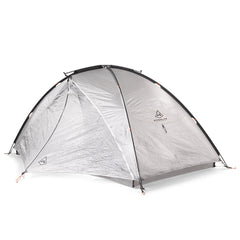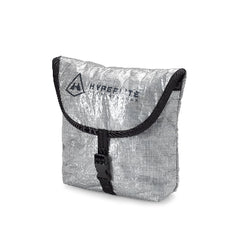Words and Photos from Jeff Garmire
In this post, our pal Jeff Garmire (@thefreeoutside) discusses the interplay between some of his favorite activities, and how each one has lifted the other ones up. What pursuits have you found support and bolster other ones you actively do or have done? Jump in the discussion!
In the first five months of 2022, I have snuck in two ultramarathons, a thru hike, and multiple backpacking trips. The seemingly unique experiences have proved more connected than I initially thought. The skills from one directly translated to successes and lessons in the others. The vast experience in the woods aided in the comfort at nighttime in an ultramarathon. The accelerated pace of a race instilled the confidence I could cover more miles while backpacking. Each trail activity aided and elevated the others. Before diving into some of the translatable skills, a short background of even finding related activities.
After a year of setting FKTs (Fastest Known Times) in 2019, I was looking for the next challenge to tackle. With the need to maintain an income, a long thru hike was out of the question. But I also wanted a way to push myself toward a concrete goal. Yet, I did not want to hang up my backpacking gear. So, ultrarunning and shorter backpacking trips became the focus. I started with long days in the mountains, proving I could potentially finish an ultramarathon. Then I signed up. The skills I had learned on the trails directly translated. Here are some of the things I learned:
REMOTE DAYS AND DARK NIGHTS ARE COMFORTABLE
My first night on my first thru hike was scary. I was alone in a seven-pound, three-person tent cowering at every tiny sound in the southern California desert. But, as the nights in nature added up, I quickly became more comfortable cowboy camping and sleeping through the sounds of the wild. I started night hiking and continued to progress in the acceptance of the night. Taking on the dark head-on and feeling comfortable sleeping in the open became a strength.

Embracing nighttime travel has opened up new doors and opportunities for adventure. I can now start a backpacking trip late on a Friday afternoon and stretch a two-day weekend into a three-day adventure. On the Sawtooth Wilderness Loop, my friend and I had a seven-hour drive to the trailhead and then a ten-mile hike into the first lake. After arriving late in the afternoon, there was no question that we could hike into the night and begin the seventy-mile loop. It gave us a full three days to enjoy the most scenic sections of the remote Idaho backpacking trip.
On another trip night, hiking paid off for exploring a national park. In December, the days were short in Death Valley, but that didn't stop me from backpacking up into remote and unexplored canyons. The blowing wind and off-trail routes were simply an adventure, far from the scary night situations of a decade prior.

In ultrarunning races, the nighttime has become one of my strengths, especially on the first night of a multi-day race. I can continue at the consistent pace I learned thru hiking. The skill has been interwoven with racing strategy and draws on years of experience in a sport I am a relative newcomer.
THRU HIKING IS MOSTLY EATING–AND SO IS ULTRARUNNING
A number of thru-hikers are having success in ultrarunning. Jack "Quadzilla" Jones won a 100-mile ultramarathon only a few days after finishing the Continental Divide Trail. Why is this? Maybe it is the comfort in being alone, enjoying long days of movement, or maybe it is the perfect fueling strategy taught by thru hiking.
In 2011 we used to joke that the biggest weight loss secret in America was the thru hiking diet: Eat whatever you want and still lose weight. Backpackers are notorious snackers with hefty appetites despite covering over 20 miles a day. The months of practice fueling during activity transition seamlessly into eating while running or fastpacking. The body simply accepts that it needs to multitask. The simple habit of eating and walking has helped me with both efficiency, energy, and enjoyment of activities beyond backpacking.
During a Last-Person-Standing event on New Year's Day, I was able to easily run the one-mile loop every fifteen minutes through the night while also eating along the way. Every time I completed a loop, I would eat a handful of goldfish crackers and then toe the start line for another loop. The slow drip and consistency of calories were significant factors in outlasting all of the other competitors. I had no stomach issues and even embraced the 30 hours of eating!
WHAT YOU HAVE IS ENOUGH… USUALLY
It was mile 208 of a 250-mile race. It was my third night racing through Arizona, and I was running on 1.5 hours of sleep. The mental clarity was gone, and the temperature was plummeting. But, my pacer was a thru hiker (and runner), and together we worked to solve our issues. We had two space blankets, one pair of light sweats, and a couple of light wind jackets. To combat the 20-degree night, Sydney tied both of the emergency blankets around her like a long skirt, and we upped our pace as fast as my exhausted body would carry me. With all our layers on, we fought through the last five miles using only what we had with us. The temperature easily could have been an excuse, but we knew the next aid station wouldn't get any closer. It is a lesson learned best on backpacking trips.

On a shoulder season adventure with my friend Jon, we neglected to read the weather forecast before setting out to backpack the 45-mile spine of the Gallatin Mountains in Montana. It snowed on night one, and we were unprepared. But, we knew we could continue without abandoning our trip. Using Ziplock bags over our socks and on our hands as gloves, we fought off the chill and completed our backpacking trip. Learning to use what you have and efficiently pivot an uncomfortable situation into a manageable one has served me well in all types of adventures.

BRINGING IT ALL TOGETHER
So many lessons are best learned while in the thick of it. When the resources are scarce and all in a backpack, it takes creativity to find a solution essential. Whether it is finding comfort in the night, fueling through a grueling day, or repurposing gear for warmth, creativity takes practice. It is a practice that many backpackers and thru hikers often experience, leading to skills that can be applied in a much wider range of activities. It is the problem-solving attitude that is one of the most beneficial to take forward in life after the trail and to build a lifetime of adventure.
Jeff Garmire is a writer and author. When he isn't adding to his 30,000 trail miles, he can be found on the trails and in the mountains around Bozeman. He is the author of Free Outside, which chronicles his Calendar Year Triple Crown.























